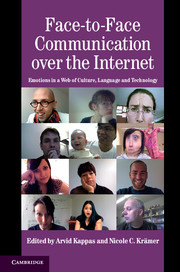Introduction
Electronically mediated face-to-face communication: issues, questions, and challenges
Published online by Cambridge University Press: 05 June 2012
Summary
In our globalized world, communication and interaction increasingly happen online and are mediated through computers and the internet. This is true not only for organizational settings and teams working together, but also for private contacts with family, friends, and even strangers (e.g., Bargh and McKenna, 2004). Theories on computer-mediated communication (CMC) that have described internet-based communication as deficit-laden compared to face-to-face communication (e.g., Kiesler, 1997; Kiesler et al., 1984; Kiesler and Sproull, 1992; Short et al., 1976; Siegel et al., 1986; Sproull and Kiesler, 1986; Strauss and McGrath, 1994) might have difficulty to explain these current developments. On the other hand, these approaches have argued that the cues we rely on in everyday face-to-face interaction are filtered out in computer-mediated communication. While this was certainly true for mere text-based interactions, more recent forms of communication via the internet have adopted numerous additional features and incorporate several of these cues (Antonijevic, 2008; Fullwood and Orsolina, 2007). This is, on the one hand, due to technological advancements, but has, on the other hand, been fostered by creative efforts of the users, as had been predicted by Walther (1992, 1996) in his social information processing and hyperpersonal communication theory. In fact, recent developments in the field of the so-called Web 2.0 show that users themselves often developed several strategies and technologies to support at least partial surrogates for face-to-face interaction, which have led to a steady increase of immediate and increasingly multimodal communication (Ramirez et al., 2002; Walther and Burgoon, 1992; Walther and Parks, 2002).
- Type
- Chapter
- Information
- Face-to-Face Communication over the InternetEmotions in a Web of Culture, Language, and Technology, pp. 1 - 14Publisher: Cambridge University PressPrint publication year: 2011
References
- 2
- Cited by

